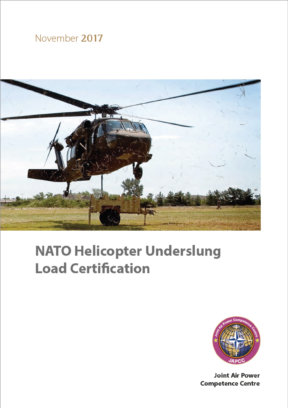Executive Summary
One method of quickly employing ground forces is through airmobile operations. When airmobile forces are employed by helicopter, part of their equipment is transported as an Underslung Load (USL) underneath the helicopter. For NATO forces to operate in a combined manner, it is essential that the equipment of one nation be transportable by the helicopters of another nation. Although Helicopter Underslung Load Equipment (HUSLE) and helicopter USL standards are available and approved in NATO, interoperability appears to be limited.
At the request of the ‘NATO Helicopter Inter-Service Working Group’ (HISWG), the Joint Air Power Competence Centre (JAPCC) completed the study to investigate the current state of interoperability of NATO helicopter USL operations. The primary objective of this study was to produce a NATO USL clearance system that will increase interoperability in USL operations among NATO nations. The study gives an overview of the current Standardization Agreements (STANAGs) and an analysis of data obtained through a questionnaire as well as through meetings and interviews with subject matter experts.
Under direction of the Military Committee Land Standardization Board (MCLSB) the HISWG is responsible for the standardization of helicopter procedures in NATO. Within the HISWG the HUSLE panel is engaged in the development and sustainment of USL standardization. Although USL STANAGs are in place, it has been identified that due to limitations in combined helicopter USL operations, interoperability has deteriorated significantly in the last decade. The reasons found for this can be summarized as:
- unclear procedures;
- lack of standardization;
- lack of documentation sharing;
- differences in HUSLE hardware.
In order to gain insight into the current issues that interfere with interoperability in USL operations, a questionnaire developed by the JAPCC was distributed to NATO and partner nations. Eight NATO nations and two non-NATO HISWG participants responded to the questionnaire.
The responses to the survey showed:
- There is no consistent authority for USL clearances.
- There is no standardized system for Military Airworthiness Authorities (MAAs) within NATO.
- Not all national MAAs appear to be involved in USL clearances.
- Most nations adhere to agreed STANAGs.
- Most nations also have to comply with additional standards and regulations.
- Not all manufacturers conform to STANAG specifications for aircraft hook dimensions.
- Foreign USL are not accepted because of the use of different or unknown standards for personnel and equipment certifications.
Suggested solutions included:
- change national manuals and regulations to conform to STANAGs;
- certify foreign USL according standards of supported nations;
- supporting units carry a secondary hook to adapt to non-standard USL connections;
- have bi-lateral agreements between involving nations;
- establish a NATO central authority.
Most of all: a simple solution is needed.
Although one NATO authority providing USL clearances could enhance interoperability, the authority of military airworthiness will remain a responsibility of the national MAAs. Initiatives within NATO for airworthiness standardization resulted in a NATO Airworthiness Policy (NAP), which was approved in 2013. Although not an airworthiness authority, the NATO Aviation Committee (AVC) was established in 2016 as a Tasking Authority (TA) on airworthiness aspects. Without affecting the sovereignty of national MAAs the AVC accepted the development of the NATO recognition Process (NRP) as directed by the NAP.
JAPCC Recommendations
To improve the interoperability during helicopter USL operations, the JAPCC recommends:
To monitor the developments on airworthiness aspects in NATO, to ensure possible positive effects on the standardization of USL certification.
Supporting units should provide a secondary hook during joint USL operations.
The development of a common static test procedure with a common format to report and share the results, in order to provide USL clearances.
The development of USL categories to allow easier acceptance of clearances.
To establish a database, accessible to all nations, containing all USL testing reports and clearances in a standardized format.
The creation of an ‘USL interoperability Matrix’, accessible to all nations, to improve the sharing of information and common knowledge. The USL Matrix must be secured in an NATO Standard Related Document (SRD).
In addition, the JAPCC recommends that NATO investigate the feasibility for the establishment of a common training centre and / or syllabus for USL-handling personnel.











